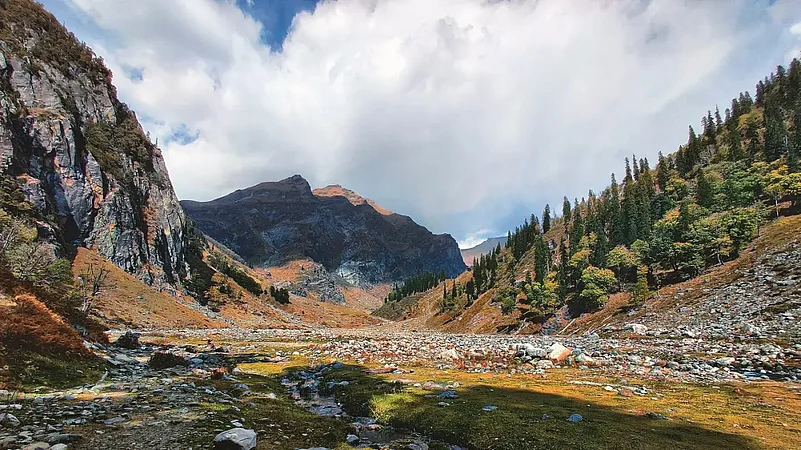As I lay in my sleeping bag and listened to the sound of soft snow falling on my tent, I reminisced about the last few days which I had spent — working on the weekdays, followed by insane adventures during the weekend. This happened to be my last night in Himachal Pradesh. The next day, I planned to hike down to the city and pack up my stuff to leave for home after spending a week and a half working from hills and then hiking to the Hampta Pass, peddling from Rohtang La to Manali and camping near the mighty Chandra Tal. All I could wonder was how this campsite could feel more like home than home itself. There was a thin layer of a tent, another thin mattress, and a not-so-cosy sleeping bag between me and the cold ground. Yet it felt like the most comfortable bedding I have slept on in my entire life.
With a series of COVID-induced lockdowns dominating the last two years, avid travellers like me had been looking for that small escape window. And the moment I saw it, I grabbed it without a second thought. It was in the middle of the day during October that I received a call from a college friend who suggested working from the hills, instead of our homes, for the next two weeks. The plan was to work during the weekdays and spend the weekends hiking and camping. Despite the
initial hesitation we hopped on this journey and booked ourselves a homestay — literally at a deadend — for two weeks.
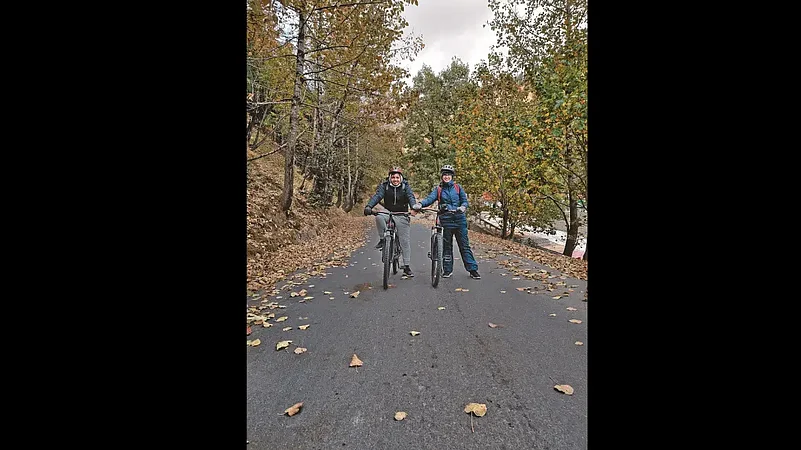
The tourist season at these places begins from late June and ends around early September. So the probability of us encountering crowds was fairly low. And as we had expected, there was nobody except our group of six.
***
We began our journey on a Friday afternoon. We reached Old Manali in the evening — it felt strange to see the otherwise overcrowded streets so deserted. We called it an early night in anticipation of the long journey the next day — to Chandra Tal. Due to the Atal Tunnel, the 140-km journey takes around six hours now, down from the 10 hours it used to take previously. We began at 8 am the next morning with our camping equipment, pre-cooked meals, warm clothes, and lots of garbage bags. The ride was a bumpy one with hardly any signs of civilisation after Khoksar. We reached the Chandra Tal camping ground at sunset. While some of us were arranging the equipment and pitching our tents, the others prepared the meals. It was a very cold night, with temperatures falling as low as -7°C; yet, we were all very enthusiastic. After engaging in some cardio the next morning to warm ourselves up, we started our hike towards Chandra Tal.
Chandra Tal is shrouded in myths and legends. Some locals will indulge you in mysterious stories of fairies sighted by some at the lake; others will talk about UFOs landing there. But it’s not the stories that gave us goosebumps. We were astonished and agonised at the same time to see it littered with candy wrappers, food packets, paper plates and even discarded clothes. The next step? We grabbed our garbage bags and started picking up the litter — and got the bags, filled to the brim, back to Manali. All of us were keen on staying at Chandra Tal for another night. But a replay of the dropping temperatures and our limited ration steered us in the opposite direction.
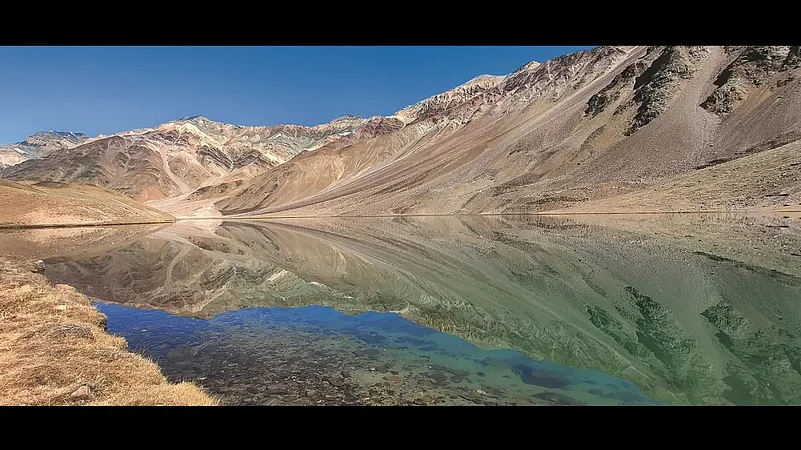
The next week was all about the early-morning long walks in the pine forests, heavy breakfasts in local cafés, and working on the laptop while absorbing the cool autumn sunshine. With all the cosiness, the motivation to work did not come easy. The usual attractions — distant snow-covered mountains, lush green forests, the sound of water flowing in the nearby stream, and the sight of the beautiful Jogini waterfall — proved to be major distractions. And giving in to the temptation, we rented mountain bikes to ride from the Rohtang Pass to Manali — a distance of 55 kms.
It was a fine, sunny morning with white, puffy clouds hovering all over the sky and a perfect opportunity to cycle. Cycling in the mountains is one of the most thrilling experiences, along with being sustainable, and is one of the best ways to enjoy what the place has to offer. It took us 4-5 hours to cover the distance. By the time we reached Manali, exhaustion took over, and we ended the day with a scrumptious meal.
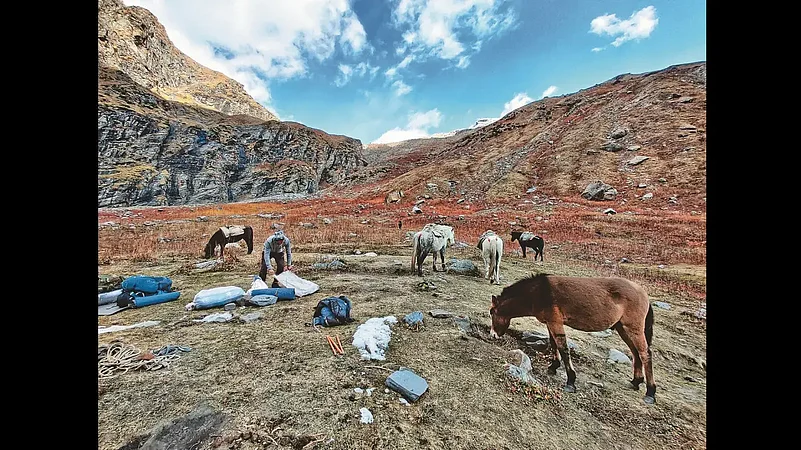
The next weekend, we trekked to the Hampta Pass. The trek is generally undertaken during the monsoons. We, however, went in October, eventually becoming the last group for the season. It is about 32 kms long, at an elevation of 4,287 m, and is fairly easy for all sorts of trekkers. Generally, it takes six days to complete the trek if one intends to cross the pass and end in Chattru. But we opted for a shorter route and managed to complete the trek in three days — instead of crossing the pass, we retraced our steps. The trek starts from a forest and the scenery quickly changes to beautiful grasslands and river crossings. One moves from the treeline towards the snowline with mountains on both sides, walking parallel to the streams. It is the Hampta Pass that divides the lush, green Kullu Valley from the treacherous and barren Lahaul Valley. One starts their journey from a hamlet called Sethan to ultimately end up in Chattru. However, amidst these surreal sights were plastic plates, wrappers, glass bottles and much more. And once again, we took out our garbage bags and ended up carrying ten of them back with us.

***
I have been trekking in the Himalayas since 2010. In the past decade, the culture of trekking has increased exponentially. On one hand, this has provided a source of income to the local communities, but, on the other, it has also led to exploitation in the name of tourism. Solid waste is accumulating at a fast pace and proper infrastructure to handle the amount of waste is not in place yet. With commercialisation at the helm of these treks, huge amounts of garbage can be seen left behind. Since 2017, I have actively aimed to become a part of the solution instead of the problem. During my travels — whether with a group or solo — I make sure that no footprint of mine is left behind. There is always a cleaning drive planned for the last day of the trek in order to leave the place just the way we found it.
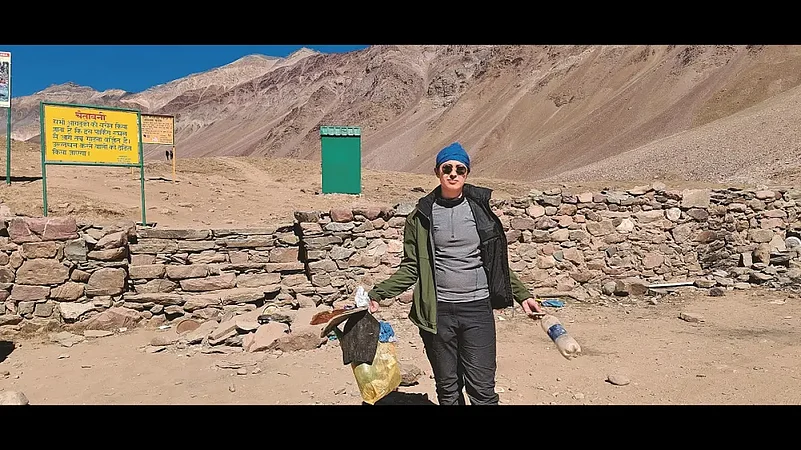
Time and again I’ve been asked — why do you trek? How can someone enjoy walking, carrying so much load, sleeping on the ground, getting sunburnt at times, or dealing with temperatures as low as -20°C? Similar to meditation, I have always found walking in the mountains to be therapeutic. I not only think about the frostbites and sore feet but also the sounds of nature, the absolute stillness that gives time to think and contemplate, the extraordinary terrain, the star-laden infinite sky and the gentle touch of the cool breeze.






